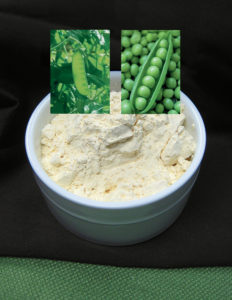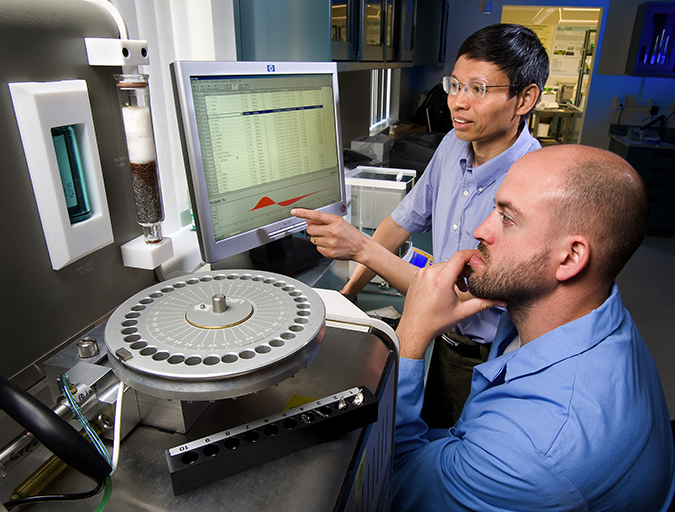Pea starch extrudes well and provides elasticity

attributes that are useful in many diets.
Twenty years ago, it was hard to find an aquaculture or pet food that did not use corn, wheat, rice or other grains. These grains provided starch that could be gelatinized in extrusion cooking and were well digested by most fish, crustaceans and other animals. Inventory was always available and at a reasonable price.
As we look at aquaculture feeds around the world today, many are made where corn and wheat may not be as available or as profitable to use. In pet food manufacturing, corn and wheat have been “demonized” as being negative ingredients, while no firm data exists to support this conclusion. Additionally, the use of corn in alcohol production has significantly increased pricing.
All of these issues have pushed feed formulators to use alternative sources of starch and protein from beans, peas, tubers and other ingredients.
Peas, peas
Peas, Pisum sativum, are identified with various common names around the world, including peas, field peas and dry peas. The two basic types – smooth and wrinkled – refer to the surfaces of the peas. Peas also have three different colors: green, yellow and yellow-green.
Peas, which are legumes, are grown all over the world and used in human foods and animal feeds. Growing peas can be advantageous in many locations because they are easily harvested and are a valuable rotation crop for soil fertility in areas dominated by grains.
With 25 percent of the world’s production, Canada is the largest producer of peas. It is also the largest exporter, with 40 percent of global pea exports. The largest use in Europe and North America is in the feed industry. The largest use in Asia and South America is in human food production, but large volumes are also used in feed production.
Nutritional value
While most of the pea production is not processed further into specific components, there is a growing availability of pea protein concentrates with protein levels from 50 to 80 percent. Peas are processed using dry or wet processing methods and then further separated using air classification and pin milling.
Some protein adheres to the starch granules even after this processing. The subsequent pea protein ingredients are nutritionally reasonable alternatives to soybean meal, providing similar methionine and tryptophan levels, but higher levels of lysine.
Pea proteins are highly digestible in aquatic species and pets. Pea protein products do not contain the trypsin inhibitor found in soybeans and have low levels of anti-nutritional factors compared to other pulse crops. Soybean products can cause immunological reactions in some animals due to the 35 antigenic proteins identified in soybeans. Additionally, as with other vegetable proteins, peas are not high in the ash or minerals found in meat and fish meals.
Studies of pea protein in some fish have shown superior growth performance and no palatability issues in fish, crustaceans or pets.
The development of pea protein products produces two major by-products: pea starch and pea fiber. Both provide nutritional and functional attributes that can be useful in many diets. It should be stated that pea starch purchased today is generally not just starch, as it could have 10 to 15 percent protein. Pea fiber from the hulls and from further processing has been shown to have good effects on digestion in some animals.
Starches, digestibility
Like all starches in native form, pea starch must be cooked or gelatinized to increase digestibility in fish or pets. Gelatinization is accomplished in extrusion with high moisture, steam, pressure and heat. Typically, extrusion that reaches a “cook” of 85 percent or more of the starch leads to good digestion and performance in the animal or fish.
Uncooked starches from legumes like peas have been shown to be more digestible than uncooked potato or high-amylose corn starch. However, it is always preferable to cook any starch well.
Cooked pea starch is a very useful energy source in many warmwater fish and crustacean diets. Pea starch is not as rapidly digested as rice starch, but overall digestion of pea starch as an energy source is high. Typically, pea starch or pea flour can be incorporated at 3 to 15 percent of the formula.
With coldwater fish feed, the amount of protein guaranteed is typically between 40 and 50 percent. The same is also true with many pet foods. As many meat and fish protein sources have declined in protein and increased in ash content over the years, formulation becomes tighter and more difficult. Because peas and pea flour are 18 to 23 percent protein, and pea starch is 10 to 15 percent protein, pea products help add more protein in the same formulation “space” compared to corn and wheat, which have 7 to 11 percent protein.
There are two major components in pea starch: amylose and amylopectin. These differ in branching and size, with amylopectin the larger component. Many legume starches exhibit a wide variation in swelling during water hydration in extrusion, but pea starch seems to be less variable.
There are some viscosity differences among pea varieties, but the floating properties desired in many aquaculture diets can be accomplished in the extrusion process. Different starches can lead to “brittle” products and yield fines in processing and delivery. Pea starch extrudes well and provides some elasticity, ultimately reducing fines.
Perspectives
So how do pea products help formulation? They provide good nutritional profiles along with good functionality. They are not sticky like some starches, which can slow down production and reduce throughput. If they are well-cooked in processing, the energy provided is high. Losses due to fines in processing can be reduced, which improves yield and reduces the delivery of food fines to fish facilities and in packaging. Overall, performance of aquatic species and pets is good. With pea production being worldwide, the use of pea products in formulations can only increase and provide another option to support business profitability.
This article was funded by: 3D Corporate Solutions, 601 North 13th Street, Monett, Missouri 65708 USA
(Editor’s Note: This article was originally published in the March/April 2014 print edition of the Global Aquaculture Advocate.)
Author
-
Dr. George Collings
Nutrition Solutions
[109,111,99,46,115,110,111,105,116,117,108,111,115,110,111,105,116,105,114,116,117,110,99,64,115,103,110,105,108,108,111,99,103]
Tagged With
Related Posts

Aquafeeds
A look at phospholipids in aquafeeds
Phospholipids are the major constituents of cell membranes and are vital to the normal function of every cell and organ. The inclusion of phospholipids in aquafeeds ensures increased growth, better survival and stress resistance, and prevention of skeletal deformities of larval and juvenile stages of fish and shellfish species.

Aquafeeds
Alternative feed ingredient universe to convene at F3 meeting
What started out as a simple yet ambitious contest to drive innovation in the aquafeed sector has evolved into a fully global competition – and collaboration – amongst ingredient suppliers and feed manufacturers.

Aquafeeds
A look at protease enzymes in crustacean nutrition
Food digestion involves digestive enzymes to break down polymeric macromolecules and facilitate nutrient absorption. Enzyme supplementation in aquafeeds is a major alternative to improve feed quality and nutrient digestibility, gut health, compensate digestive enzymes when needed, and may also improve immune responses.

Aquafeeds
A new nutrient for aquaculture, from microbes that consume carbon waste
Biotechnology firm NovoNutrients aims to produce a line of nutraceutical aquafeed additives as well as a bulk feed ingredient that can supplement fishmeal. Its process includes feeding carbon dioxide from industrial gas to a “microbial consortium” starring hydrogen-oxidizing bacteria.


